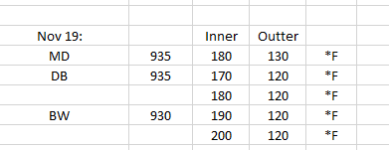Cookie
Well-known member
- May 5, 2021
- 1,992
- 2,309
I use whatever the Kartek Buggy guy gives me. I do my CV's every 50 days of duning, I have never had to replace any CV ever.
Follow along with the video below to see how to install our site as a web app on your home screen.
Note: This feature may not be available in some browsers.
The clicking just tells you they're workingJust a good ole rehash of a 3 year old thread to argue about grease. LETS FIGHT. I say wheel bearing grease from autozone works just fine
Was helping a friend troubleshoot battery issues with his coach out there. I could hear someone driving around in circles and asked about it. Friend says "he's driving in circles trying to hear his CVs click."The clicking just tells you they're working
I wouldn't expect a CV to ever reach those temperatures. Maybe @parker@gearone has some insight on Cv temps.103 is only good to 375*f where 101 is good to 500*f
Just a good ole rehash of a 2 year old photo of your car... something about a wheel bearing.Just a good ole rehash of a 3 year old thread to argue about grease. LETS FIGHT. I say wheel bearing grease from autozone works just fine
This is why I stepped up from WD40 to wheel bearing grease for my CVs, and from vaseline to WD40 for my hubs.Just a good ole rehash of a 2 year old photo of your car... something about a wheel bearing.
I HF IR gun'd my CVs (which are at a less than ideal angle at ride height) after a 1 hour fast ride all over hell and gone. Want to say it was in the 200s. Wonder how the viscocity is at those temps. Seems to be right in the middle of operating window.I wouldn't expect a CV to ever reach those temperatures. Maybe @parker@gearone has some insight on Cv temps.
I like the viscosity of the 103 is better than the 101, so if temp isn't an issue I might try it.
I've done the same thing, about 220-225F is what the CV body was reading.I HF IR gun'd my CVs (which are at a less than ideal angle at ride height) after a 1 hour fast ride all over hell and gone. Want to say it was in the 200s. Wonder how the viscocity is at those temps. Seems to be right in the middle of operating window.
I did a test on our buggies one day. we were all in a row running the same path for the same amount of time. we normally ran for 30 min to 60 min @ a time. when we would stop I would jump out of my buggy & take the temps on the CV body with a temp gun.I wouldn't expect a CV to ever reach those temperatures. Maybe @parker@gearone has some insight on Cv temps.
I like the viscosity of the 103 is better than the 101, so if temp isn't an issue I might try it.

You should never see CV joints pushing 400*... Most duners probably get there joints from 160-240* as stated by board members above. Believe it or not super finishing the joints dropped the operating temp of the cv joint by 14 - 16* per our tests... So it does more than just make it look shinnyI wouldn't expect a CV to ever reach those temperatures. Maybe @parker@gearone has some insight on Cv temps.
I like the viscosity of the 103 is better than the 101, so if temp isn't an issue I might try it.
There should be zero grease in the boot. Grease in the boot will cause the boot to fall off or tear. I suggest watching the following video for a good tutorial.Not to hijack the thread.
3rd season with a sandcar. When cleaning, re-assembling, re-greasing before the season, how much grease is needed in the boot? My logic says to put a ton in there because there is room for it.
I've never put grease in the boot. I fill the cup and both sides of the joint. Eventually, it does end up in the boot, and I add more. After 1-2 cycles, I generally don't need anymore grease unless I want it all over my buggy.Not to hijack the thread.
3rd season with a sandcar. When cleaning, re-assembling, re-greasing before the season, how much grease is needed in the boot? My logic says to put a ton in there because there is room for it.
Fill the cup with belray, fill the CV with Swepco and call it a day. None in the bootNot to hijack the thread.
3rd season with a sandcar. When cleaning, re-assembling, re-greasing before the season, how much grease is needed in the boot? My logic says to put a ton in there because there is room for it.

